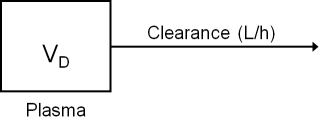Pharmacokinetic one-compartment model
Pharmacokinetics refers to the rate and extent of distribution of a drug to different tissues, and the rate of elimination of the drug. Pharmacokinetics can be reduced to mathematical equations, which describe the transit of the drug throughout the body, a net balance sheet from absorption and distribution to metabolism and excretion.
Widmark (1919) did experimental studies with bolus and constant administration of compounds, and analyzed the results based on model with a single compartment, which can be easily calculated with exponential function. A certain amount of drug (A0) is administered at constant rate k01. The amount of drug in the body (A1) and the amount of cleared drug (A2) are dependent also on the elimination rate constant k12.Differential equations for A1 and A2 are:
If drug is given intravenously as a fast bolus injection, it is often assumed that the drug is immediately distributed in the compartment A1. Then the remaining amount of the drug at time t can be calculated as:
Samples of plasma can be easily obtained, and if plasma concentrations, CP(t), are measured after the bolus administration, the clearance and VD of the drug can be estimated by fitting the model (Figure 2) to the data.

In case of one-compartment model with oral first-order absorption the plasma concentrations can be modelled with two exponential functions
The differential equations can be used to simulate the concentration or amount of drug in the body at different time points with different drug administration regimes. If one compartment model is not sufficient to describe drug kinetics, then two or three compartment model can be used (Krüger-Thiemer, 1968).
See also:
- PK two-compartment model
- PK three-compartment model
- Whole-body physiology-based pharmacokinetic model
- Plasma pharmacokinetics in PET
- Receptor occupancy
- Enzyme inhibition
- Binding potential
- Compartmental model ODEs in PET
- Whole-body model for [15O]H2O
References:
Bergström M, Långström B. Pharmacokinetic studies with PET. Progr Drug Res. 2005; 62: 280-317. doi: 10.1007/3-7643-7426-8_8.
Bourne DWA: Mathematical Modeling of Pharmacokinetic Data. CRC Press, 1995. ISBN 1-56676-204-9.
Fischman AJ, Alpert NM, Rubin RH. Pharmacokinetic imaging - a noninvasive method for determining drug distribution and action. Clin Pharmacokinet. 2002; 41(8): 581-602. doi: 10.2165/00003088-200241080-00003.
Jann MW, Penzak SR, Cohen LJ (eds.): Applied Clinical Pharmacokinetics and Pharmacodynamics of Psychopharmacological Agents. Adis, Springer, 2016. doi: 10.1007/978-3-319-27883-4.
Kuepfer L, Niederalt C, Wendl T, Schlender JF, Willmann S, Lippert J, Block M, Eissing T, Teutonico D. Applied concepts in PBPK modeling: how to build a PBPK/PD model. CPT Pharmacometrics Syst Pharmacol. 2016; 5(10): 516-531. doi: 10.1002/psp4.12134.
Rosenbaum S (ed.): Basic Pharmacokinetics and Pharmacodynamics - An Integrated Textbook and Computer Simulations. 2nd ed., Wiley, 2017. ISBN 9781119143154.
Wagner JG. Linear pharmacokinetic equations allowing direct calculation of many needed pharmacokinetic parameters from the coefficients and exponents of polyexponential equations which have been fitted to the data. J Pharmacokin Biopharm. 1976; 4(5): 443-467. doi: 10.1007/BF01062831.
Yamaoka K, Nakagawa T, Uno T. Statistical moments in pharmacokinetics. J Pharmacokinet Biopharm. 1978; 6(6): 547-558. doi: 10.1007/BF01062109.
Zamuner S, Di Iorio VL, Nyberg J, Gunn RN, Cunningham VJ, Gomeni R, Hooker AC. Adaptive-optimal design in PET occupancy studies. Clin Pharmacol Ther. 2010; 87(5): 563-571. doi: 10.1038/clpt.2010.9.
Tags: Pharmacokinetics, Drug development, Plasma, Clearance
Updated at: 2023-05-05
Created at: 2019-01-08
Written by: Vesa Oikonen